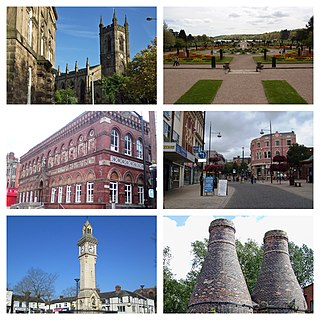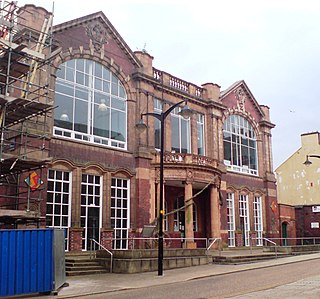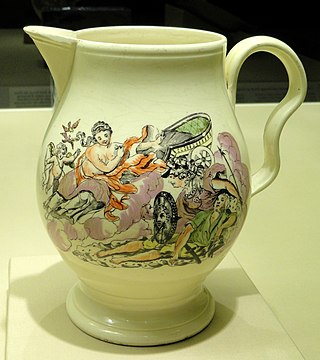Related Research Articles

Staffordshire is a landlocked ceremonial county in the West Midlands of England. It borders Cheshire to the north-west, Derbyshire and Leicestershire to the east, Warwickshire to the south-east, the West Midlands county and Worcestershire to the south, and Shropshire to the west. The largest settlement is the city of Stoke-on-Trent; the county town is Stafford.

Stoke-upon-Trent, also called Stoke, is one of the six towns that along with Hanley, Burslem, Fenton, Longton and Tunstall form the city of Stoke-on-Trent, in Staffordshire, England.

Stoke-on-Trent is a city and unitary authority area in Staffordshire, England, with an area of 36 square miles (93 km2). In 2021, the city had an estimated population of 258,400. It is the largest settlement in Staffordshire and is surrounded by the towns of Newcastle-under-Lyme, Alsager, Kidsgrove and Biddulph, which form a conurbation around the city.

Susan Vera Cooper OBE was a prolific English ceramic designer working in the Stoke-on-Trent pottery industries from the 1920s to the 1980s.

Hanley is one of the six towns that, along with Burslem, Longton, Fenton, Tunstall and Stoke-upon-Trent, amalgamated to form the City of Stoke-on-Trent in Staffordshire, England.

The Staffordshire Potteries is the industrial area encompassing the six towns Burslem, Fenton, Hanley, Longton, Stoke and Tunstall, which is now the city of Stoke-on-Trent in Staffordshire, England. North Staffordshire became a centre of ceramic production in the early 17th century, due to the local availability of clay, salt, lead and coal.

Tunstall is one of the six towns that, along with Burslem, Longton, Fenton, Hanley and Stoke-upon-Trent, amalgamated to form the City of Stoke-on-Trent in Staffordshire, England. It was one of the original six towns that federated to form the city. Tunstall is the most northern, and fourth largest town of the Potteries. It is situated in the very northwest of the city borough, with its north and west boundaries being the city limit. It stands on a ridge of land between Fowlea Brook to the west and Scotia Brook to the east, surrounded by old tile-making and brick-making sites, some of which date back to the Middle Ages.

Charlotte Rhead was an English ceramics designer active in the 1920s and the 1930s in the Potteries area of Staffordshire.
Portmeirion is an English pottery company based in Stoke-on-Trent, England. They specialise in earthenware tableware.

Burslem School of Art was an art school in the centre of the town of Burslem in the Potteries district of England. Students from the school played an important role in the local pottery industry. Pottery was made on the site of the school from the early Middle Ages. The venue was refurbished and re-opened for the arts in 1999.
Shelton is an area of the city of Stoke-on-Trent in Staffordshire, England, between Hanley and Stoke-upon-Trent.
Stoke-upon-Trent was a parliamentary borough in Staffordshire, which elected two Members of Parliament (MPs) to the House of Commons from 1832 until 1885, and then one member from 1885 until 1918, when the borough was enlarged, renamed Stoke-on-Trent, and split into three single-member constituencies.
Dorothy Jessie Tait was a prolific English ceramic designer working in the Stoke-on-Trent pottery industries, most prominently for Midwinter, from the 1940s to the 1980s.
Gordon Mitchell Forsyth (1879–1952) was a Scottish ceramic designer and fine artist and art education innovator.
Reginald George Haggar (1905–1988) R.I., A.R.C.A., F.R.S.A. was a British ceramic designer. He was born in Ipswich and studied at Ipswich School of Art and the Royal College of Art. In 1929, he became assistant designer at Mintons pottery in Stoke-on-Trent, rising to art director six months later, a post he held until 1939. Working in water colours and ceramics, his designs reflected both the radical and lyrical elements of the Art Deco style.

Chell is a suburb of the city of Stoke-on-Trent in the ceremonial county of Staffordshire, England, that can be subdivided into Little Chell, Great Chell and Chell Heath. It lies on the northern edge of the city, approximately 1-mile (1.6 km) from Tunstall, 2 miles (3.2 km) from Burslem and 3 miles (4.8 km) from the county border with Cheshire. Chell borders Pitts Hill to the west, Tunstall to the south west, Stanfield and Bradeley to the south, with the outlying villages of Packmoor and Brindley Ford to the north and Ball Green to the east. Since 2011 the area has been divided into the electoral wards of Bradeley & Chell Heath, Great Chell & Packmoor and Little Chell & Stanfield.
Predominantly centred on Hanley and Burslem, in what became the federation of Stoke-on-Trent, the 1842 Pottery Riots took place in the midst of the 1842 General Strike, and both are credited with helping to forge trade unionism and direct action as a powerful tool in British industrial relations.

William Greatbatch was a noted potter at Fenton, Staffordshire, from the mid-eighteenth to the beginning of the nineteenth centuries. Fenton was one of the six towns of the Staffordshire Potteries, which were joined in the early 20th century to become the city of Stoke-on-Trent in Staffordshire, England.

Millicent (Millie) Jane Taplin (1902–1980) was a British designer and painter of ceramics who spent most of her career at Josiah Wedgwood and Sons (1917–1962). She was trained in painting by Alfred and Louise Powell, and supervised Wedgwood's ceramics painters. She became a designer of decorative patterns in 1929 and by the mid-to-late 1930s was one of the company's main designers, although she did not design pottery shapes. She was one of only two working-class women to become a successful ceramics designer before the Second World War. Her tableware designs were exhibited by Wedgwood at Grafton Galleries in London in 1936, and several of her designs are now on display at the V&A Museum. Her design "Strawberry Hill", with Victor Skellern, was awarded the Council of Industrial Design's Design of the Year Award in 1957.
Victor G. Skellern (1909–1966) was a British ceramics designer and stained glass producer who was the art director at Wedgwood from 1934 to 1965. He helped to modernise Wedgwood, and his design work was a factor in the company's resurgence after 1935. He was also known for employing well-known designers from outside the company. Skellern's ceramics designs were exhibited at Grafton Galleries (1936) and the Britain Can Make It exhibition (1946) in London. Some of his designs are now on display at the V&A Museum, Yale Center for British Art, Museum of Applied Arts & Sciences and the Wedgwood Museum. His design "Strawberry Hill", with Millicent Taplin, was awarded the Council of Industrial Design's Design of the Year Award in 1957.
References
- ↑ Grant, Tina. International Directory of Company Histories, Volume 88. St. James Press, 2007, p. 309.
- ↑ Victoria and Albert Museum. British art and design, 1900-1960: a collection in the making. 1984, p. 98.
- ↑ Stoke and Hanley Rate books 1907-1916
- ↑ The Pottery Gazette and Glass Trade Review, September 1933 p.1124
- ↑ Conway, Hazel (1987). Design History: A Students' Handbook. Harper Collins. p. 35. ISBN 9780415084734.
- ↑ Josiah Wedgwood V writing to Sir Cecil Weir in September 1941
- ↑ British Industries Fair. The Pottery Gazette and Glass Trade Review: June 1915, June 1916 p.388, March 1917 p.262, April 1918 p.309, April 1919 p.356, April 1920 p.475, April 1921 p.596-7, April 1922 p.560, April 1923 p.656, June 1924 p.1016, April 1926 p.602-3, April 1927 p.632, April 1928 p.624, April 1929 p.606, April 1930 p.606, April 1931 p.542, April 1932 p.492, February 1933 p.203, February 1934 p.222, February 1935 p.231, Feb 1936 p.248, February 1937 p.250, February 1938 p.248, February 1939 p.251. Pottery and Glass May 1947 p.47. The Pottery Gazette and Glass Trade Review: May 1948 p.417, May 1949 p.504b, June 1950 p.852, June 1951 p.738.
- ↑ Rodgers, Don (7 April 2012). "What's in a name? DON RODGERS Bargain Hunter.(Features)". Western Mail (Wales) . Retrieved 1 January 2013.
- ↑ "Obituaries: Susie Cooper". The Independent. 1 August 1995. Retrieved 14 April 2012.
- ↑ Pottery and Glass Record, December 1937 p.320